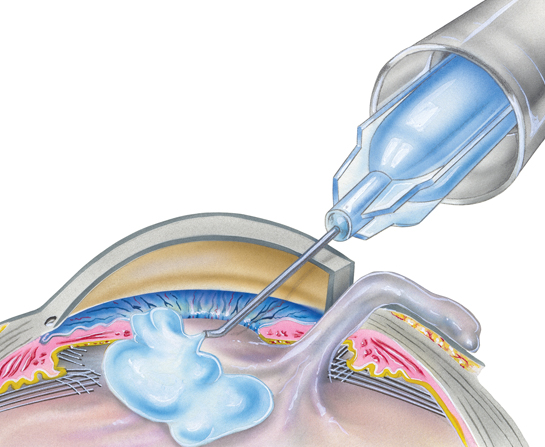Cataract Unclouded
April 29, 2022 Return

Most people know that the big ‘C’ refers to cancer in the oncology world but not many may realize what the big ‘C’ stands for in the ophthalmology field. It is none other than cataract. According to consultant ophthalmologist Dr Shin Hoy Choong, “The 2014 National Eye Survey reported that more than 43,000 Malaysians are blind from cataract, and it’s estimated that over 670,000 cataract surgeries have to be performed within the next four to five years in Malaysia.”
Things aren’t looking too good on a global scale as well. Worldwide, roughly 24 million intraocular lenses (IOLs) are used annually to restore vision post-cataract surgery. If you thought this was alarming, Dr Shin cautions that the figures are expected to increase due to the ageing population. With such worrying statistics, it’s not hard to see why cataract holds the big ‘C’ title.
Under the magnifying glass
To first understand what cataract is, we must comprehend the structures of the eyes. Dr Shin Hoy Choong explains, “The lenses in our eyes are made out of water and proteins. They’re important because they keep the lenses clear so light can pass through. But with factors such as age and certain medical conditions, these proteins gradually clump together and cloud the lenses. As a result, a person’s vision becomes blurry, foggy or completely impaired.”
Elaborating on factors which can up one’s risk of cataract, he says, “An individual’s environment (eg, prolonged exposure to the sun’s UV rays), unhealthy lifestyle habits (eg, smoking or excessive drinking) and family history all play a role. And it is these factors which determine the type of cataract the person will have.”
The various types of cataracts are:
Nuclear cataract
– The most common type of cataract.
– Typically linked to ageing.
Secondary cataract
– Caused by diseases (eg, glaucoma and diabetes) and the usage of medication (eg, steroids), which are associated with cataract development.
Traumatic cataract
– May result from an eye injury, even though it may not develop immediately. In certain cases, traumatic cataract will only form years after the injury.
Congenital cataract
– Some babies are either born with cataracts or develop them during childhood. Congenital cataracts often occur in both eyes but may be so minimal that vision remains unaffected.
Radiation cataract
– May develop after being exposed to radiation eg, cancer treatment.
Watching out for cataract
How does one know if they have cataract? Dr Shin lists down a number of tell-tale symptoms.
– Cloudy or blurry vision
– Glares or lights appear to be too bright
– Colours seem faded or washed out
– Poor night vision
– Sudden change in prescription power of eyeglasses or contact lenses
– Eye fatigue
– Frequent tearing
– Double vision or multiple images in one eye
Diagnosing cataract

“Cataracts are diagnosed by an ophthalmologist through a comprehensive eye examination. This includes an eye chart test to measure the patient’s vision at various distances, as well as a dilated eye exam to evaluate their retina and optic nerve for any signs of damage among other eye problems. Additionally, the patient will undergo tonometry, a test which measures the eyes’ internal pressure.
Surgery: A Silver Lining
“If the patient is diagnosed with symptoms of early cataract, their vision can be improved with new eyeglasses, brighter lighting or anti-glare sunglasses. However, if these measures don’t work, there’s another solution – and it comes in the form of lens replacement surgery.
“During lens replacement surgery, a small incision is made in the eye’s frontal surface with a laser or a scalpel, and the cataract lens is typically broken into smaller pieces with a laser or an ultrasonic device so that it can be easily removed from the eye via suction. Once all the cloudy lens’ remnants are extracted, an intraocular lens (IOL) is inserted in replacement of the natural lens to restore vision. In most cases, the eye heals quickly post-surgery without the need for stitches.”
As there are various types of cataracts, there are also various types of IOLs. “Examples of IOLs include standard monofocal lens, multifocal lens, toric lens and extended range of vision lens. The ophthalmologist will help the patient select the kind of IOL which best suits their lifestyle. For instance, someone who spends most of their time on the computer requires a different sort of lens compared to someone who often plays golf.”
Worried about surgery? Don’t be.
Patients may be fearful and hesitant to undergo surgery but he offers assurance. “With technological advances, surgery can now be performed with very small incisions, resulting in faster healing and lower risk of complications. Besides that, most IOLs are now made of foldable material, allowing them to be rolled up during their insertion into the eye and unfolded once they’re placed inside.”
Dr Shin emphasizes, “Lens replacement surgery is one of most successful surgical procedures available. Based on my experience, the overall success rate is 99% and above.”
References:
1. Abbott Medical Optics Inc (2015). What is an IOL? Infographic.
2. Abbott Medical Optics Inc (2016). What are cataracts? Infographic.
3. All About Vision. Available at www.allaboutvision.com
4. American Optometric Association. Available at www.aoa.org
5. Dell, S.J. (2015). Extended Depth-of-Focus IOLs. Available at http://crstoday.com
If you like this article, do subscribe here.
